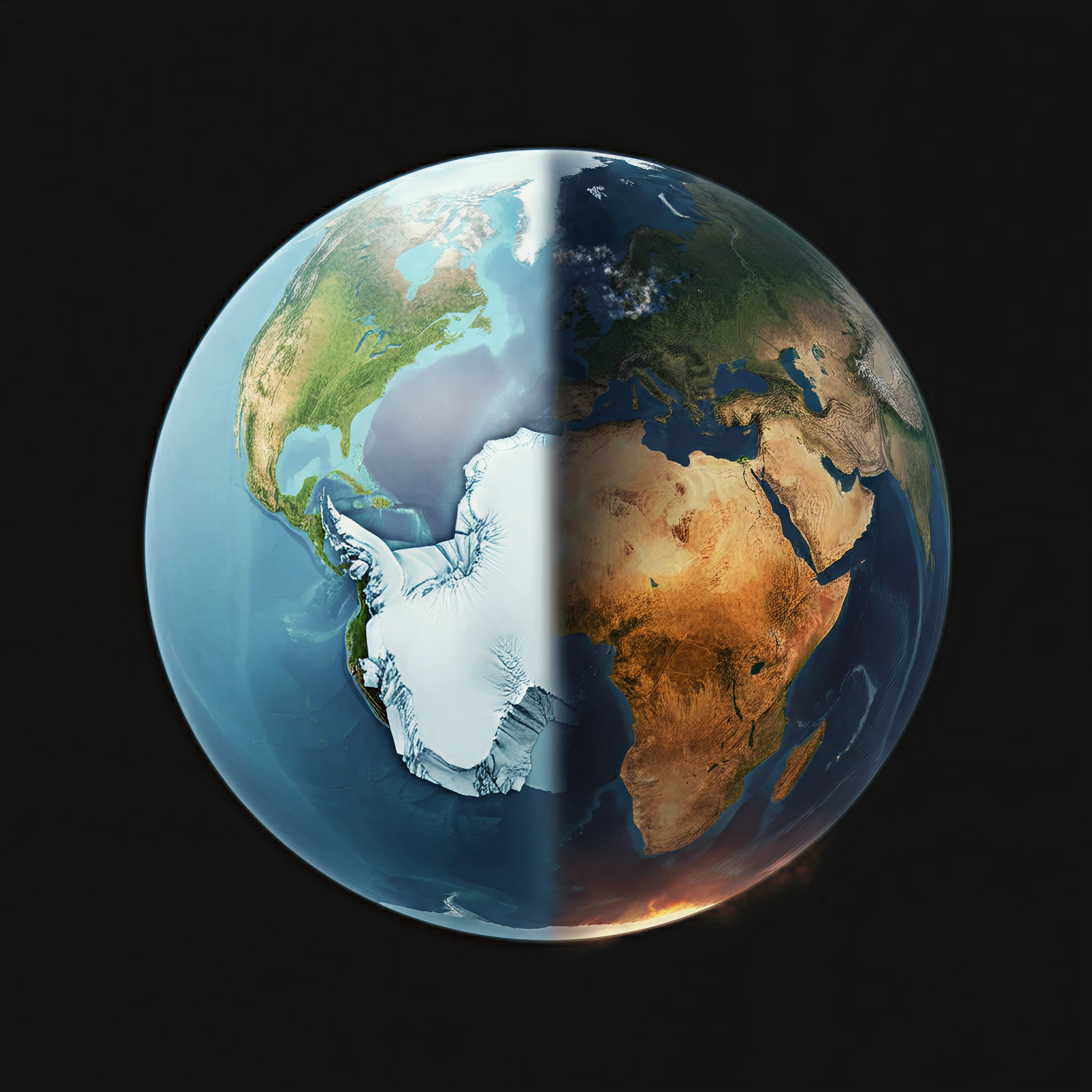Introduction
On December 7, 1972, the world marveled at the first full view of Earth captured on camera by the Apollo 17 crew. Dubbed the “Blue Marble,” the image symbolized the planet’s beauty and fragility. It also sparked an environmental consciousness that many people still carry to this day. Fast forward 50 years, new satellite images tell a starkly different story. The planet we saw glowing in that iconic photograph has since been dramatically reshaped. Climate change, driven by human activities, has left visible marks on Earth that even space can’t ignore.
This article explores how these changes are reflected from above, focusing on some of the most dramatic transformations visible from space.
I. Antarctic Ice Sheet Reduction
Satellite imagery today reveals one of the most notable and alarming changes since the 1972 Blue Marble image: the rapid shrinking of the Antarctic ice sheet. This massive loss of ice has been tied to rising global temperatures, contributing to rising sea levels and threatening coastal communities worldwide. Research shows that some of these ice losses may now be irreversible, a stark warning about our planet’s future.
Why does it matter? The Antarctic ice sheet plays a vital role in regulating Earth’s climate and maintaining ocean ecosystems. Its decline is a major indicator of global warming.
II. Expansion of the Sahara Desert
Over the past five decades, the Sahara Desert has expanded by approximately 10%. From space, this is visible as an encroaching beige blur swallowing previously greener regions of Africa. This desertification is attributed to warming temperatures and changing rainfall patterns caused by climate change.
Why does it matter? The Sahara’s expansion has disrupted ecosystems, forced the migration of local communities, and put additional pressure on already scarce water and agricultural resources.
III. Retreat of Rainforests
Rainforests, particularly the Amazon, have shrunk significantly in the last five decades. From space, their retreat is apparent as once-dense green canopies are replaced by barren lands or agricultural plots. The Amazon itself now faces deforestation rates so intense that large portions of it risk transitioning into savannah.
Why does it matter? Rainforests are among the planet’s best defenses against climate change, storing carbon dioxide and housing exceptional biodiversity. Their decline threatens ecosystems, wildlife, and the global climate.
IV. Deforestation and Loss of Vegetation
Deforestation isn’t limited to the tropics. Across continents, large-scale logging, agriculture, and urban expansion have turned forests into fragmented landscapes. This change is clearly visible in satellite imagery, with brown scars cutting across previously lush regions.
Why does it matter? Earth’s forests serve as the planet’s lungs, absorbing carbon dioxide and producing oxygen. Their destruction accelerates global warming and disrupts habitats.
V. Increased Frequency of Wildfires
Wildfires have more than doubled in frequency over the past 20 years, and their smoky aftermath is now visible from thousands of miles above the Earth. Satellites document vast swathes of charred landscapes in places like California, Australia, and the Mediterranean.
Why does it matter? These fires release massive amounts of carbon dioxide into the atmosphere, worsening climate change. They also destroy homes, wildlife, and ecosystems at an unprecedented rate.
VI. Urbanization and Expansion of Urban Areas
The bright lights of human civilization visible in nighttime satellite images have grown dramatically since 1972. Cities have ballooned in size, with once-green areas now paved over for urban sprawl. The glow of urban lights now stretches across previously dark corners of the world.
Why does it matter? Urbanization drives habitat loss, increases pollution, heightens resource consumption, and creates heat islands that contribute to temperature increases.
VII. Increased Pollution
Satellite imagery also reflects the rise in pollution, particularly in regions undergoing rapid industrialization. Smog clouds, visible as hazy blankets in places like China and India, highlight the scale of particulate pollution. Rivers and oceans, too, appear discolored from waste and runoff.
Why does it matter? Pollution harms human health and destroys ecosystems. It also accelerates climate change by releasing harmful gases into the atmosphere.
VIII. The Blue Marble Today: Insights from NASA’s EPIC Camera
NASA’s Earth Polychromatic Imaging Camera (EPIC) provides a window into these transformations in unprecedented detail. Launched aboard the Deep Space Climate Observatory (DSCOVR), EPIC captures high-resolution images of Earth from a million miles away.
EPIC’s data confirms visible changes, from shrinking ice caps and deforestation to altered atmospheric conditions. Beyond just images, EPIC tracks ozone levels, vegetation cover, and even particle sizes in pollution, offering scientists valuable tools to monitor Earth’s health.
Why does it matter? By understanding these changes, we can better strategize solutions to combat the effects of climate change, from reforestation to reducing emissions.
Looking Ahead
The changes visible in Earth’s “Blue Marble” over the past 50 years are a sobering reminder of our planet’s fragility and the profound impact humans have had. While these transformations may seem daunting, they also reinforce the urgency for collective action to safeguard the planet for future generations.
The original Blue Marble photograph from 1972 represented a moment of unity and environmental reflection. Today, it serves as a rallying cry, urging all of us to take steps toward climate action.
Seeing Earth from space has an extraordinary way of changing perspectives. Astronauts often speak of the “Overview Effect”—a sense of awe and interconnectedness that comes from viewing our planet as a fragile, glowing orb in the vast expanse of space. The rest of us may not have that opportunity, but images like the Blue Marble and data from satellites like EPIC remind us of that same truth.
Call To Action:
Climate change is changing the face of our planet, but we still have the power to act. Share this article to raise awareness, or find ways to support environmental initiatives. Every step counts in writing a better story for the Blue Marble.








